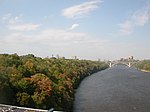Minnehaha Academy
1884 establishments in MinnesotaAC with 0 elementsAll pages needing cleanupEducational institutions established in 1884Educational institutions established in 1913 ... and 4 more
Private elementary schools in MinnesotaPrivate high schools in MinnesotaPrivate middle schools in MinnesotaSchools in Hennepin County, Minnesota

Minnehaha Academy (often abbreviated MA) is a Christian private school in Minneapolis, Minnesota, United States, for students in preschool through 12th grade, and established in 1913. There are two campuses, the South Campus for preschool through 8th graders, and the North Campus, for 9th through 12th graders. It is a ministry of the Northwest Conference of the Evangelical Covenant Church, and is located in the Cooper and Hiawatha neighborhoods on West River Parkway. The student body is drawn from Minneapolis, St. Paul, and throughout the Minneapolis–Saint Paul metropolitan area, as well as several international students.
Excerpt from the Wikipedia article Minnehaha Academy (License: CC BY-SA 3.0, Authors, Images).Minnehaha Academy
West River Parkway, Minneapolis
Geographical coordinates (GPS) Address Phone number Website External links Nearby Places Show on map
Geographical coordinates (GPS)
| Latitude | Longitude |
|---|---|
| N 44.945833333333 ° | E -93.205555555556 ° |
Address
Minnehaha Academy North Campus
West River Parkway 3100
55406 Minneapolis
Minnesota, United States
Open on Google Maps









